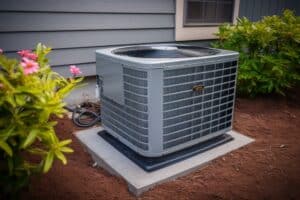We Promise It’s More Than Just a Metal Box In Your Yard

You might not realize it, but the truth is that your condenser is a crucial component of your heating, ventilation, and air conditioning system. It plays a critical role in the cooling process. Understanding how it works can help you get the most from your air conditioning. So buckle your seat belts, and let’s dive into the secrets of this important but seemingly mysterious part of your HVAC system.
It Starts with the “Principles of Heat Exchange”
Condensers operate using a concept referred to as the “principles of heat exchange.” Sounds a little like Game of Thrones, but it really just means the process of utilizing refrigerants to transfer heat from indoor spaces to outdoor environments. In an air conditioning system, refrigerant absorbs heat from indoor air, causing it to evaporate and transform into a low-pressure gas. This gaseous refrigerant is then compressed by the compressor, raising its temperature and pressure. Got it? Good.
Next Up: Cooling and Condensation
Once the refrigerant is compressed, it flows into the condenser coil, usually located in the outdoor unit of the HVAC system, also known as….THE CONDENSER! As this hot, high-pressure refrigerant travels through the condenser coil, it releases heat to the surrounding air, causing it to cool and condense back into a liquid state. This process of condensation is crucial for removing heat from the refrigerant and preparing it for the next stage of the cooling cycle, which we will describe below.
Understanding Heat Dissipation and Outdoor Ventilation
The condenser coil is meant to facilitate heat dissipation and outdoor ventilation, allowing the condensed refrigerant to release heat efficiently. This coil is made of finned tubes or coils constructed of copper or aluminum, which in turn provide a large surface area for heat transfer. The outdoor unit of the HVAC system, also known as … THE CONDENSER … contains a fan that blows outdoor air over the condenser coil, facilitating heat exchange and cooling. Now it’s ready for business!
Get Ready for Pressure Regulation and Expansion
As the refrigerant condenses in the condenser coil, its temperature and pressure decrease, preparing it for expansion and further cooling. This high-pressure liquid refrigerant leaves the condenser coil and goes into the expansion valve (also referred to as a metering device), which in turn regulates its flow and reduces its pressure. This expansion valve allows the refrigerant to expand rapidly, causing its temperature to drop significantly as it enters the evaporator coil. Is this suitable for a science project or what?
But How Well Does It Work?
The efficiency and performance of a condenser depend on various factors, including the design, size, and refrigerant capacity of the unit. Furthermore- and this is where you come in: good maintenance, including regular cleaning and inspection of the condenser coil, is essential. Leaf debris, kids’ toys, dirt and other detritus from the average backyard can really take a toll on this kind of equipment. The fact is that a well-maintained condenser can enhance the overall efficiency of the HVAC system, reducing energy consumption and operating costs while maximizing cooling capacity and comfort. As for the consequences of a poorly maintained one …. well, it’s not pretty.
So there you have it. Your condenser is an integral component of your HVAC system, responsible for the cooling and condensing of refrigerant to remove heat from your indoor space. And now that you have the right terminology, you can impress your friends and colleagues, not to mention your certified HVAC tech, with your knowledge.
It could be time for HVAC maintenance. Get the trusted resource for all your heating and cooling needs in the San Gabriel Valley, since 1969! Call Air-Tro today at 626-357-3535.
